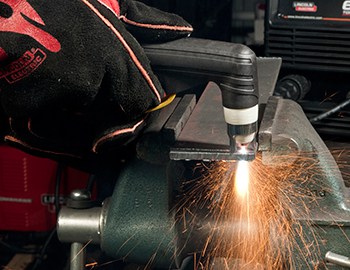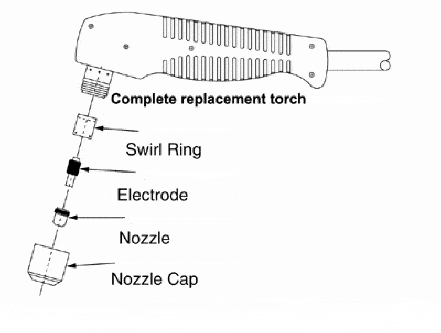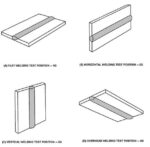Welding and fabrication industry do not only join metals together; there’s much more to it that is they make beautiful metal structures and vehicles and for that matter, only joining metals through welding isn’t enough! They need to make precision cuts into the metals to give them beautiful shapes and to form the desired structures and that is where a plasma cutter comes into use!
 Yes, a plasma cutter is used in the welding industry to form precision cuts into the metals. But is it same as welding? The answer is no, but yes, a plasma cutter is used in welding for faster and attractive cutting processes. You definitely require to use the plasma cutter to cut the metals in the required shapes before joining the pieces together.
Yes, a plasma cutter is used in the welding industry to form precision cuts into the metals. But is it same as welding? The answer is no, but yes, a plasma cutter is used in welding for faster and attractive cutting processes. You definitely require to use the plasma cutter to cut the metals in the required shapes before joining the pieces together.
And how does it work?
Well, a plasma cutter usually uses an electrically conductive gas (specifically argon) in order to transfer the energy from the power supply to the conductive material thus, melting the metal to form a cut. This is done by using the electrons in the plasma at a very high speed which in turn melts the metals!
Well, down this article I will tell you in details about plasma cutters, how to use them, what are its benefits, is plasma cutting the same as welding, hazards related to its use, the safety gears you need to wear to use a plasma cutter, how does the plasma cutter work, what are its components, and also many other frequently asked questions!
So, if you are a beginner in plasma cutting,
Don’t you worry!
Because…
This article is going to make you a pro in using a plasma cutter!
So, let’s begin the journey….
What is a plasma cutter?
From the introduction part of this article, you know what a plasma cutter is! Right?
But, do you have an idea of what a plasma is?
If not, a plasma is the fourth state of matter that is when the level of heat in steam increases to its highest levels, it becomes electrically charged to become plasma!
A plasma cutter uses this electrically conductive plasma to cut metals in various shapes in the welding process. Generally, a gas is heated through the chamber at a very high temperature, which produces the plasma arc and then the electrons in the plasma are used at the highest speed to melt metals to form cuts in them.
How does a plasma cutter work?
Just like other welding processes, a plasma cutter makes use of a gas in order to form the plasma arc which ultimately cuts through the metals!
Confused how does it work?
Let’s have a deeper understanding of the process…
Similar to the torch used in welding, a plasma cutter makes use of the plasma arc torch. The torch in turn makes use of the swirl ring in order to spin the gas all round the electrode. When the gas is heated in the chamber of the torch, it forms the plasma arc. The plasma arc then proceeds to the narrow opening of the torch to cut through the metals by melting them!

What are the components of a plasma cutter?
Before learning how to use a plasma cutter, you need to be acknowledged with the components of a plasma cutter which are as follows:
1.) Power supply:
A power supply is used to convert the AC Voltage into a DC Voltage that helps to maintain the plasma arc throughout the process.
2.) The arc starting console:
It helps to produce the AC Voltage that ultimately produces the spark inside the plasma torch to create the plasma arc.
3.) The consumable parts:
It includes the shields, retaining caps, deflectors, tip, nozzle, swirl ring, and the electrodes.
4.) The plasma torch:
It is used to provide the perfect alignment and cooling of the consumable parts.
5.) Built-in air compressors:
The plasma cutters that come with a built-in air compressor helps to maintain a steady supply of air in the machine while you cut metals. However, not all plasma cutters come with the built-in air compressors.
6.) Outlet:
An outlet is a must for a plasma cutting machine. It has to match the plug of the machine and it can be of 110volt or 220volt depending on the volt of the machine.
7.) The moisture filter:
This does not come with the plasma cutter machine, but you need to purchase it separately. It makes sure that only clean and dry air is sent to the plasma from the air compressor.
How to use a plasma cutter?
Let us now learn how to use the plasma cutter step by step:
1.) Clean your surrounding area of any inflammable liquids and open the windows and doors for proper ventilation in the room.
2.) The first thing that your plasma cutter needs is air pressure and to provide the same, turn on the air compressor.
3.) The next step is to clamp the metal on a steady surface and at such a height that it does not touch your face. Also make sure to establish the clamp at a safe distance from you so that the metal does not drop on you when it melts.
4.) Now, plug in the plasma cutter machine and the air hose.
5.) Adjust the settings of the amperage according to the thickness of the metal you are about to cut. In general, the thicker the metal to be cut, the higher should be the amperage of the machine.
6.) See if the torch has all its essential components, especially the trigger guard that helps to align the material you are about to cut. Remember, the torch won’t work unless it has the trigger guard in it.
7.) Mark the line that you need to cut on the metal with the help of a chalk.
8.) Wear your safety equipment before you begin cutting and position yourself furthest from the metal and still in a position to be able to see clearly where you are cutting on the metal.
9.) Lastly, press the torch on and start cutting the metal. You may have to cut through several times in order to get the precision and perfection in the cut to deliver the finest shape required.
What are the different types of plasma cutters?
The most common types of plasma cutters are as follows:
The miller spectrum 875 plasma cutter or the miller plasma cutter:
The weight of the miller plasma cutter is only 21lbs and it offers the best cutting power in 60 amps package. It can perfectly cut through 7/8” mild steel. It is in fact, one of the most liked portable plasma cutters used in the industries.
The CNC plasma cutter:
This plasma cutter is run by the computer it is attached to and is used by most industries, manufacturing companies and fabrications. It is one of the most expensive plasma cutters that is available in the market till date as it uses computerized technology in order to run.
See also: The Best Plasma Cutter for CNC Tables
What are the hazards associated with using a plasma cutter?
You should be aware of the following safety hazards while using a plasma cutter:
-
-
- If there are any flammable liquids surrounding the area you are going to use the plasma cutter, it can ignite and cause severe burns.
- The sparks from the metal while cutting can hit your face or body and cause burns and blisters.
- If not taken proper care, the molten cut metal can fall on your legs and injure them.
- You can accidentally touch the hot metal or the plasma arc can reach your hand accidentally.
-
What PPE do you need to use the plasma cutter?
As you have seen that the plasma cutter can impose serious hazards, therefore wearing of the following safety equipment becomes utmost essential:
-
-
- Face shield or a plasma helmet
- Safety gloves that are heat and fire resistant
- A welding beanie is required in order to protect your hair from the sparks of the arc
- Safety jacket in order to protect you from the flame and sparks
- Work jeans in order to protect your legs from the flames and sparks
- A good pair of EH rated work boots
-
Benefits of using a plasma cutter:
Following are the benefits of using a plasma cutter:
-
-
- It helps to make precision cuts in the metals that you are going to weld later
- It helps to lower the cost of cutting
- It helps to improve productivity and help in large scale productions
-
How do you weld using a plasma cutter?
Welding with plasma cutter is very similar to TIG welding. Similar to the TIG welding, in a plasma arc welding, a tungsten electrode is located within a copper nozzle that has a small opening at its tip. The plasma cutter uses the plasma to produce the electric arc that ultimately melts the metal to be fused together.
What gas is used in a plasma cutter?
The gases used in a plasma cutter are: argon, oxygen and nitrogen. But mostly argon gas is made use of in a plasma cutter.
Can you cut with a TIG welder?
Yes, a TIG welding torch can be used to cut metals but the cuts produced will not be as perfect and fine as that made by the use of a plasma cutter.
Can a welder cut metal?
Yes, a welder can cut through metals usually of thickness 1/8” thickness. A wire feed welder with 220volts can cut through ¼” sheet metal but at the cost of using higher electricity, time and inert gas.
What air pressure is required for plasma cutting?
The air pressure required for plasma cutting will be anywhere between 55 to 70 psi. Thinner metals requiring lesser amperages will require lesser air pressure of around 45 psi.
Can you cut stainless steel with plasma cutter?
Yes, you can cut any conductive metal like steel, mild steel, alloys of steel, aluminum, etc. with the help of a plasma cutter.
Can you use a MIG welder as a plasma cutter?
Yes, you can do so by inserting a carbon electrode instead of a welding stick. The air arc it will produce will cut through the metal like the plasma cutter, however, the cuts produced will not be of the same quality as that of a plasma cutter.
And it’s a wrap!
So, you see you can definitely use a welder as a plasma cutter, but a plasma cutter will only cut metals in precision but never be able to join them together.
But a plasma cutter is an inevitable part of welding as you need to cut the metals in proper shape before joining them together!
Just do not forget to wear your safety gears before using the plasma cutter and enjoy the finest cut metals!
That’s all with this post!
Hope to meet you soon in my next column. Till then…
Have a happy welding and plasma cutting!







